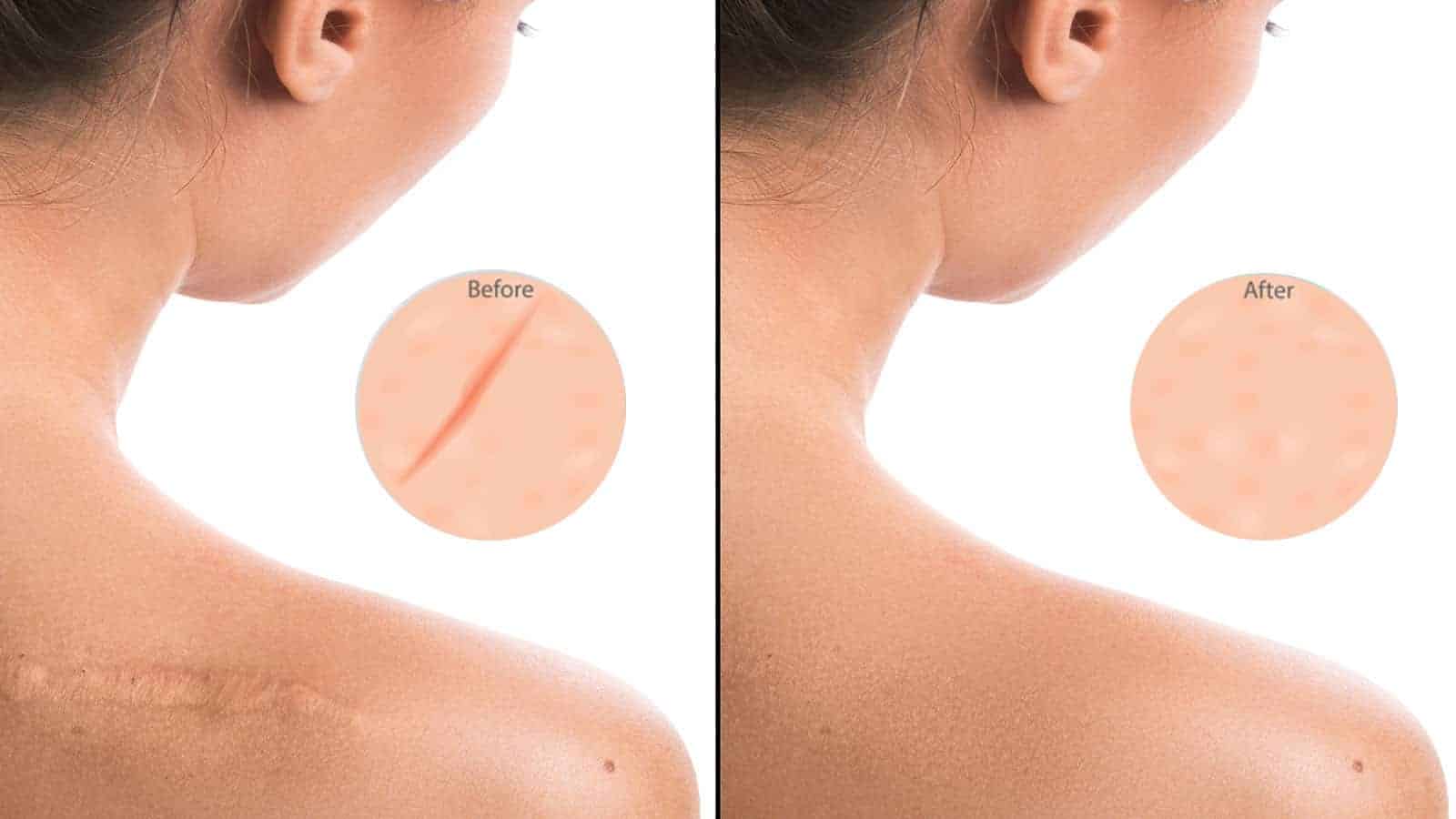Scars are an inevitable result of the body’s natural wound-healing process – often stirred into action when the skin is damaged. Scarring usually results from events like accidents and surgeries, as the result of a skin condition (e.g., acne), or from certain diseases (e.g., kidney disease).
From a health standpoint, scars are a good thing and a sign that the body’s wound repair apparatus works. Appearance-wise, however, scars can leave something to be desired – namely, diminishment or removal. This is especially true if injury or illness causes scarring to visible body parts like the arms, face, legs, or neck.
While they cannot be entirely made invisible, there are certain things we can do to reduce the visible effects. In this article, we will educate you about scars, including how and why they form, their types, and how to reduce or (mostly!) eliminate them. Let’s get going!
How do scars form?
Physiologically, scars form when the dermis – a deep and thick layer of the skin – is damaged. When this happens, our body automatically forms new collagen fibers around the damaged area. After the repair process, a scar forms.
Collagen is the most abundant protein in our bodies. Besides providing the raw material for patching scars, collagen is also vital to connective tissues, making the ligaments, muscles, skin, tendons, and other body parts. Unsurprisingly, collagen is mentioned several times when discussing ways to reduce the visibility of scars.
Newly formed scar tissue forms when the wound heals entirely and has a different texture and quality from the adjacent tissue. Certain kinds of scars, however, can take on a strikingly dissimilar appearance from average, neighboring skin. Let’s go over the different kinds of scars now.
Types of scars
There are various kinds of scars, each sorted into classes based on color, pattern, presentation (visual appearance), and texture. General types include hypertrophic scar, keloid scar, normal scar, suture scar, and widespread scar.
Hypertrophic scars:
These scars resemble keloid scars in appearance but do not go beyond the boundaries of the injury. Hypertrophic scars result from excessive deposits of collagen that result in the formation of elevated replacement skin tissue. Hypertrophic scars often result from events like body piercing, burns, cuts, and pimples.
Normal scar:
A typical scar results from the healing process following a typical injury (i.e., no surgery, disease, etc.) It appears soft and thin, and its skin pigmentation is close to the surrounding tissue. These “mature” over a few weeks to months before the final repair process. As maturation continues, the mark’s color, size, and thickness are reduced.
Keloid scars:
Keloid scars are the result of an overactive healing process. These are often irregularly shaped, elevated, and darker than the surrounding skin. Texturally, they may be rough and jagged. They often form beyond the boundary of the initial injury (e.g., the outline left by a blade following skin penetration.)
As the name implies, suture scars result from suturing required in some surgical procedures. Sutures are simply rows of stitches that are the edges of a wound together.
Widespread scars:
Widespread scars are characteristically flat, pale, and broad in appearance. Texturally, they are very soft. Widespread scars do not elevate, and the tissue appears different than the surrounding, non-affected tissue. A widespread scar commonly forms following the deep penetration of a sharp object into the skin.
Reducing or (Mostly) Eliminating Scars
Yes, there are legitimate ways to reduce or (mostly) eliminate scars. The methods mentioned here range from super simplistic to surgical technology and innovation marvels. Here they are:
Take Niacin
Method: Oral niacinamide
Description: A form of vitamin niacin (B3) that is a staple recommendation from dermatologists for treating various skin problems.
How it Works: Oral niacinamide possesses potent antibacterial, immunomodulatory, and anti-inflammatory qualities – essential for skin health and healing.
Dermatologists state that oral B3 helps treat the red scars that result from acne lesions. Oral B3 may also help to counteract the hyperpigmentation of the skin that some scars produce, facilitate collagen production, and texturize the rougher skin patches that sometimes result from scarring.
Research: Scientists theorize that niacin is effective for treating skin problems due to its co-factoring effect with two important biochemicals (NAD+/NADH and NADP+). Both chemicals are crucial to the repair of skin cells when the skin becomes damaged.
In a 35-subject animal study published in the journal Trauma Monthly, scientists found that oral B3 is effective in healing wounds and accelerating tissue regeneration – a critical element of proper scar healing and size reduction.
Look for Retinol (or better yet, Retinoid)
Method: Topical application (i.e., applied directly to the skin).
Description: Topical supplements and medicines that serve mainly to counteract the effects of aging. They have recently shown effective for some people in the healing of tissue.
Both the similarities and differences between retinol and retinoid are significant. Retinoids, plural, as a group of compounds, come from vitamin A. They have been shown in scientific studies to reduce the appearance of signs of aging – fine lines, wrinkles, and pigmentation. Retinol is just one type of retinoid that is available over the counter. It is a less potent version of the substance class from which it gets its name.
How it works: Retinoids work by altering the composition of skin cells and accelerating cell death, therefore catalyzing new cell growth. Secondarily, retinoids also form a “barrier” around collagen cells, preventing the quick breakdown of the glycoprotein and thickening the deeper layer of skin (dermis) where the wrinkles first begin to form.
Research: Retinoids are a favorite of dermatologists because of the vast litany of scientific publications exposing their benefits. Recently, dermatologists and other scientists have begun to uncover the potential role of these drugs in the treatment of scar tissue.
Per a study undertaken by Johns Hopkins University and published in the Journal of the American Academy of Dermatology, the application of topical adapalene demonstrated a beneficial effect in the treatment of acne scar tissue.
In another study, twice daily application of topical retinoic acid over three months decreased the size and symptoms both hypertrophic and keloid scars by 77-79%. It is similar to success in applying retinoid treatments to various scar tissues.
Laser Resurfacing
Method: Laser-guided skin treatment options.
Description: Many types of lasers and laser procedures are advertised in the skincare market. Each type caters to different skin problems. Regarding reducing or eliminating acne scarring, the preferred laser treatment involves using the fractional carbon dioxide – or “fractional CO2” – laser.
How it works: Laser resurfacing procedures use specialized lasers to improve the skin’s appearance and treat facial flaws, including certain scars. Laser resurfacing may necessitate the use of general anesthesia (often used in surgery) or intravenous sedation (“twilight sleep”).
The CO2 laser uses a high-energy, short pulsed light beam (known as ultra pulse) or continuous light beams running in a scanning pattern to penetrate and remove thin layers of skin and, ideally, any imperfections in the area. Recovery from CO2 laser resurfacing takes up to two weeks.
Research: Most clinical studies report that CO2 laser resurfacing is quite successful, especially as the treatment modality for acne scars. Per a study published in the Journal of Cutaneous and Aesthetic Surgery, laser resurfacing is the “most effective treatment option for atrophic acne scars [indented scars that heal immediately below the epidermis].”
In a 107-patient study published in the Journal of Dermatologic Surgery, researchers from Singapore studying the safety and efficacy of fractional CO2 laser treatments in treating acne scars reported that virtually the entire study population showed skin texture improvement. (Sixteen of the 107 patients did experience adverse effects, however, including hyperpigmentation and blistering.) Nearly 35 percent of all patients experienced a 50 percent or more reduction in the amount of scar tissue.
Final Thoughts: Other Tips
According to the American Academy of Dermatology, one can take steps to reduce the appearance of scars caused by an injury. Here they are in order:
1) Keep the cut or scrape clean: Gently wash the wound with mild soap and water.
2) Use petroleum jelly: Petroleum jelly (“Vaseline”) works to keep the wound moist and prevent scabbing. It can also reduce itchiness and discomfort.
3) Use an adhesive bandage or gauze pad: After steps one and two, apply a quality adhesive bandage. If you have sensitive skin, using a non-adhesive gauze pad with tape may be wise.
4) Change the bandage or gauze daily and apply sunscreen until the wound completely heals.


















